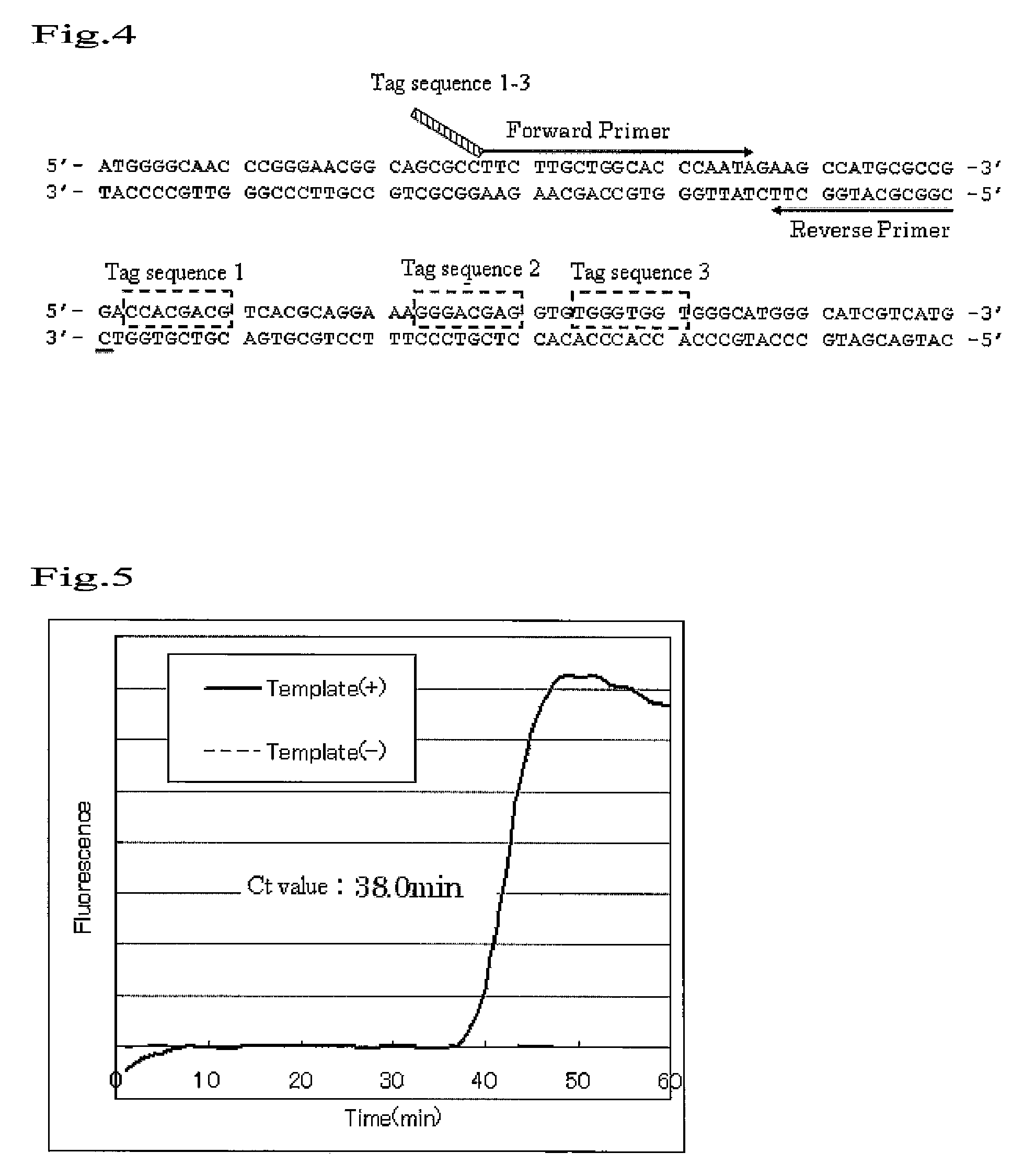Nucleic acid amplification method
a nucleic acid and amplification technology, applied in the field can solve the problems of complex temperature control, high cost, and high cost, and achieve the effect of simple, high-sensitivity and efficient generation of nucleic acid amplification methods
- Summary
- Abstract
- Description
- Claims
- Application Information
AI Technical Summary
Benefits of technology
Problems solved by technology
Method used
Image
Examples
example
Example 1
Nucleic Acid Amplification by Primer having a Tag (Effect of the Position of Tag)
(1) Preparation of Nucleic Acid Sample Solution Containing Target Nucleic Acid Fragment
[0095]3.0 ng of Hunan Genomic DNA (produced by Clontech) was heated at 98° C. for 3 minutes to be single-stranded, and a sequence in a β2AR gene was then amplified under the following conditions.
[0096]Primers were designed using a β2AR gene as a target. Each primer sequence is as shown below.
[0097]
Primer (1) (Forward 1):5′-CCACGACGCTTGCTGGCACCCAATA-3′(SEQ ID NO:1)Primer (2) (forward 2):5′-GGCAGGAACTTGCTGGCACCCAATA-3′(SEQ ID NO:2)Primer (3) (Forward 3):5′-TGGGTGGTCTTGCTGGCACCCAATA-3′(SEQ ID NO:3)Primer (4) (Reverse)5′-CCGGCGCATGGCTT-3′(SEQ ID NO:4)
[0098]Details of the positional relationship of the aforementioned primers to the β2AR gene are as shown in FIG. 4.
[0099]8 nucleotides (Tag) at 5′ end of the primers (1), (2) and (3) are substantially identical with each sequence downstream of the sequence which is s...
example 2
Nucleic Acid Amplification by Primer having a Tag (Effect of the Length of Tag)
(1) Preparation of Nucleic Acid Sample Solution Containing Target Nucleic Acid Fragment
[0130]3.0 ng of Human Genomic DNA (produced by Clontech) was heated at 98° C. for 3 minutes to be single-stranded, and a sequence in a β2AR gene was then amplified under the following conditions.
[0131]Primers were designed using a β2AR gene as a target. Each primer sequence is as shown below.
[0132]
Primer (5) (Forward5):(SEQ ID NO:15)5′-TGGTCTTGCTGGCACCCAATA-3′Primer (6) (Forward6):(SEQ ID NO:16)5′-TGGGTGGTCTTGCTGGCACCCAATA-3′Primer (7) (Forward7):(SEQ ID NO:17)5′-TGGGTGGTGGGCCTTGCTGGCACCCAATA-3′Primer (8) (Forward8):(SEQ ID NO:18)5′-TGGGTGGTGGGCATCTTGCTGGCACCCAATA-3′Primer (9) (Revesre2):(SEQ ID NO:19)5′-TCCCTTTCCTGCGTGAC-3′
[0133]Details of the positional relationship of the aforementioned primers to the P2AR gene are as shown in FIG. 11.
[0134]A nucleotide sequence (Tag) which is substantially complementary with 4 nucle...
PUM
| Property | Measurement | Unit |
|---|---|---|
| isothermal temperature | aaaaa | aaaaa |
| temperature | aaaaa | aaaaa |
| carbon number | aaaaa | aaaaa |
Abstract
Description
Claims
Application Information
 Login to View More
Login to View More - R&D
- Intellectual Property
- Life Sciences
- Materials
- Tech Scout
- Unparalleled Data Quality
- Higher Quality Content
- 60% Fewer Hallucinations
Browse by: Latest US Patents, China's latest patents, Technical Efficacy Thesaurus, Application Domain, Technology Topic, Popular Technical Reports.
© 2025 PatSnap. All rights reserved.Legal|Privacy policy|Modern Slavery Act Transparency Statement|Sitemap|About US| Contact US: help@patsnap.com



